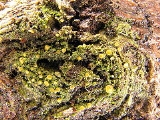
Orbilia
Encyclopedia
The Orbilia are a genus
of fungi in the family
Orbiliaceae
. Anamorphs of this genus include the Arthrobotrys
, Dactylella
, Dicranidion
, Dwayaangam
, Helicoön, Monacrosporium
, and Trinacrium.
The taxon was established in 1849 by Fries
to accommodate the species Peziza leucostigma. The mycologist Velenovský wrote articles describing species found in Bohemia
and Moravia
(Czechoslovakia
). In 1951, Seaver recorded 20 species in North America
, and Dennis later described 9 species from Venezuela
Genus
In biology, a genus is a low-level taxonomic rank used in the biological classification of living and fossil organisms, which is an example of definition by genus and differentia...
of fungi in the family
Family (biology)
In biological classification, family is* a taxonomic rank. Other well-known ranks are life, domain, kingdom, phylum, class, order, genus, and species, with family fitting between order and genus. As for the other well-known ranks, there is the option of an immediately lower rank, indicated by the...
Orbiliaceae
Orbiliaceae
The Orbiliaceae are a family of saprobic sac fungi in the order Orbiliales. The family, first described by Nannfield in 1932, contains 288 species in 12 genera. Members of this family have a widespread distribution, but are more prevalent in temperate regions...
. Anamorphs of this genus include the Arthrobotrys
Arthrobotrys
Arthrobotrys is a genus of mitosporic fungi in the family Orbiliaceae. There are 71 species.-Species:*Arthrobotrys aggregata Mekht. 1979*Arthrobotrys alaskana Matsush.) Oorschot 1985...
, Dactylella
Dactylella
Dactylella is a genus comprising 72 species of mitosporic fungi in the family Orbiliaceae. They are notable for trapping and eating nematodes.-Species:*Dactylella acrochaeta Drechsler 1952*Dactylella alaskana Matsush. 1975...
, Dicranidion
Dicranidion
Dicranidion is a genus comprising 13 species of fungi in the family Orbiliaceae.-Species:*Dicranidion amazonense Matsush. 1981*Dicranidion argentinense Speg. 1910*Dicranidion dactylopagum Peek & Solheim 1955...
, Dwayaangam
Dwayaangam
Dwayaangam is a genus of fungi in the family Orbiliaceae consisting of 8 species.-Species:*Dwayaangam colodena Sokolski & Bérubé 2006*Dwayaangam cornuta Descals 1982*Dwayaangam dichotoma Nawawi 1985...
, Helicoön, Monacrosporium
Monacrosporium
Monacrosporium is a genus of fungi in the family Orbiliaceae. There are 53 species.-Species:*Monacrosporium ambrosium Gadd & Loos 1947*Monacrosporium aphrobrochum Subram. 1964...
, and Trinacrium.
The taxon was established in 1849 by Fries
Elias Magnus Fries
-External links:*, Authors of fungal names, Mushroom, the Journal of Wild Mushrooming.*...
to accommodate the species Peziza leucostigma. The mycologist Velenovský wrote articles describing species found in Bohemia
Bohemia
Bohemia is a historical region in central Europe, occupying the western two-thirds of the traditional Czech Lands. It is located in the contemporary Czech Republic with its capital in Prague...
and Moravia
Moravia
Moravia is a historical region in Central Europe in the east of the Czech Republic, and one of the former Czech lands, together with Bohemia and Silesia. It takes its name from the Morava River which rises in the northwest of the region...
(Czechoslovakia
Czechoslovakia
Czechoslovakia or Czecho-Slovakia was a sovereign state in Central Europe which existed from October 1918, when it declared its independence from the Austro-Hungarian Empire, until 1992...
). In 1951, Seaver recorded 20 species in North America
North America
North America is a continent wholly within the Northern Hemisphere and almost wholly within the Western Hemisphere. It is also considered a northern subcontinent of the Americas...
, and Dennis later described 9 species from Venezuela
Venezuela
Venezuela , officially called the Bolivarian Republic of Venezuela , is a tropical country on the northern coast of South America. It borders Colombia to the west, Guyana to the east, and Brazil to the south...

